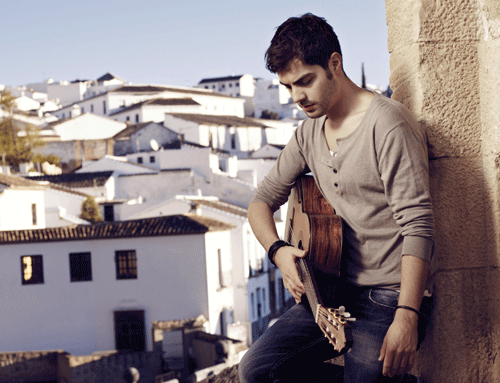A SUNDAY FESTIVAL AT THE PLAYHOUSE
Milos Karadaglich, guitar; Han-Finkel-Setzer Trio - Playhouse, February 17, 2013
Milos Karadaglich
It is a rare event in Vancouver to have classical concerts in both the afternoon and evening in one day and in one venue. This particular Sunday at the Vancouver Playhouse featured exactly this: the eagerly-awaited-for young guitarist, Milos Karadaglich performed in the afternoon for the Vancouver Recital Society, followed by the Han-Finkel-Setzer Trio (two core members of the Emerson Quartet plus pianist Wu Han) under the auspices of Friends of Chamber Music.
Given all the plaudits that 30 year old Milos Karadaglich has already received throughout the world (and the many comments on his striking ‘good looks’), one might have expected something a bit flashy and brilliant at this concert. In fact, we got almost the opposite: a modest, yet engaging, artist of refinement and sensibility who always manages to communicate his deep love for the music he plays. Right from the opening Bach Lute Suite in C minor, one was immediately impressed by the artist’s control over the guitar’s many timbres and textures, much of the playing soft and inward but always aware of the music’s motion. It would be difficult to think of playing more selfless and natural than this.
The majority of the concert was devoted to South American composers that the artist has just recorded. Many of their pieces are very atmospheric and throughout Milos was able to suspend the listener within the exact atmosphere that fit the piece, whether it be sad, contemplative, energetic, or mysterious. In the distinguished Villa Lobos works, we saw structural awareness and carefully-judged tonal weight, the ‘valsa choro’ in particular featuring deliciously sprung rhythms. The compositions by Morel, Codosa, Savio, and Leo Brouwer, gave us ample evidence of just how much reserve this artist has: when he punctuated the texture with decisive attack, or pushed into strong motoric rhythms, it really meant something! While the distilled beauty of Barrios’ Un Sueno en la Floresta, with its evocative tremolo, was pretty disarming, the highlight of the night was the suite Koyunbaba (1985) by Carlo Domeniconi. Starting from a toccata-like structure, it moves over a wide range of feelings -- some pagan, others more mystical – but always maintains an emotional unity. Milos was quite magnetic in conveying all the different shadings in this work, strong and commanding at key points but wonderfully meditative and musing at others.
It is clear that Milos has substantial artistic maturity already; equally, he has a keen and subtle intellect to place beside his very strong technique. He truly loves the guitar and all it can do. In the ‘Ask the Artist’ session after the concert, the most interesting insight that came out is how disciplined Milos is: he loves the pace of non-stop performing but, aware that this can really push your technique out of balance, always appreciates a full day of practice where he can re-ground himself in guitar fundamentals. His first CD for Deutsche Grammophon was ‘Mediterraneo’ (0289 479 9547 6), followed by ‘Latino’ (0289 479 0063 4) last June.
For those that might have been felt a little sleepy for the second concert, the Han-Finkel-Setzer Trio was the perfect antidote: a bold and brazen ensemble that thoroughly enjoys their own power and virtuosity. The energy and brilliance of these veteran players certainly remind one of some of today’s young ‘stars’ more than Milos does. The high projection of their playing is also physically demonstrative: pianist Wu Han must have set some sort of record for leaving her piano bench to bring the full weight to climactic notes. Indeed, much visceral excitement, and daring too: this ensemble attacks works something like the owner of a new sports car who really wants to see what it feels like to ‘let everything out’.
The most successful performance on this occasion was the Dvorak Piano Trio No. 3, given a detailed, alert and very integrated treatment, powerful and objective in feeling and generating a strong cumulative excitement by the end. Perhaps the weight applied to the emotional utterances of the slow movement and elsewhere was a little excessive, making the angst in this work seemingly more an inspiration of 21st C. Hollywood than 19th C. Bohemia. But the clarity and force of the playing was remarkable. Here the only downside was that, exposing so clearly all the instances of imitative question and answer between violin and cello, did make the work appear more repetitious.
The famous Mendelssohn Piano Trio in D minor unfortunately did not fare as well, losing most of its charm and beauty, and buckling structurally, when inflated to a larger scale. The outer movements were much less smiling and free than usual, losing their natural motion under the Brahmsian weight applied. The most touching and intimate of the movements, the second, somehow was turned into a full-scale orchestral serenade, while the third ended up mainly as exercise to demonstrate rhythmic thrust. For those reared on the legendary performances of the Beaux Arts and Suk Trios, or more recently, the Florestan Trio, the Han-Finkel-Setzer performances may have the slight feeling of a bull let loose in a china shop. But it is always good to hear performances on the extremes, even if one would not want to return to them very often. Besides, they provided just the right variety to give us a very special Sunday at the Playhouse.
© Geoffrey Newman 2013

